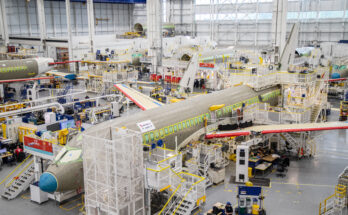by Richard Pettibone, Aerospace & Defense Companies Analyst, Forecast International.
While new aircraft orders have slowed lately, the production of commercial aircraft is exceptionally vibrant. Airbus and Boeing are maintaining tremendous backlogs, and both manufacturers are ramping up production of their new fuel-efficient aircraft designs. This robust market is one that UTC Aerospace Systems is especially well positioned to capture. The combined entity offers a vast amount of product content – one-stop shopping – for commercial aircraft primes. The combination should also offer economies of scale, making product costs lower and even more attractive.
This combined power is also one of the key factors that led to the scuttling of Honeywell’s 2016 offer to buy United Technologies. A combined UTC-Honeywell would have owned substantial content on many aircraft programs, thus decreasing competition and increasing the combined firm’s marketing power. It’s no wonder, then, that many aircraft OEMs were quite vocal in their opposition to the deal. Facing such heat, Honeywell backed away from the proposal. However, as these same OEMs continue to put pricing pressure on their suppliers, the need to consolidate and reduce costs remains. It may only be a matter of time before another offer surfaces.
And one may be made shortly. This time, UTC is the buyer and Rockwell Collins is the target. Over the past few weeks, industry news reported that UTC and Rockwell Collins were in talks over a possible acquisition valued at over $20 billion. The key driver behind this effort is the increasing pricing pressure being placed on subcontractors by industry primes such as Boeing and Airbus.
By combining operations, a UTC/Rockwell would have greater leverage in negotiating cost-reduction agreements. Such a merger would enable the combined firm to offer nose-to-tail components to OEMs. Rockwell Collins – which makes cabin and flight deck components (and soon seats with its recent purchase of B/E Aerospace), military equipment, and other parts and services – would complement, with little overlap, UTC Aerospace Systems’ existing product line. More importantly, the smaller scale of the company’s relative size – Rockwell’s roughly $8 billion (including the newly acquired B/E Aerospace) in sales versus the $15 billion in additional sales of a UTC/Honeywell merger – should make the deal more palatable to anti-trust regulators and OEMs.
A deal could be wrapped up shortly according to a recent news report in The Wall Street Journal.
Regardless, UTC Aerospace Systems will remain well positioned for growth based on its increased content on new commercial and military aircraft. The operation’s broad position across many platforms, combined with increased airframer production rates, will drive sustainable long-term aftermarket growth. Further, UTC Aerospace Systems holds a strong position for future commercial jet opportunities, thanks to the breadth of its operations.
Still, one vulnerability for the company is the increased reliability of the new aircraft that are entering service. If these aircraft prove to be as durable as has been forecast, the need for replacement parts at airline maintenance stations will decline, putting pressure on UTC Aerospace Systems’ revenue stream.
The Defense & Aerospace Companies series focuses on worldwide aerospace and defense prime contractors and subcontractors. Concise reports provide data on individual corporations regarding recent mergers, restructurings, and joint ventures, along with a Strategic Outlook that examines the company’s strengths, weaknesses, and opportunities. Also included in each report are financial and industrial segment data, snapshot coverage of major aerospace and defense programs, and recent U.S. Department of Defense contract awards.
A military history enthusiast, Richard began at Forecast International as editor of the World Weapons Weekly newsletter. As the Internet grew in importance as a research tool, he helped design the company's Forecast Intelligence Center and currently coordinates the EMarket Alert newsletters for clients. Richard also manages social media efforts, including two new blogs: Defense & Security Monitor, covering defense systems and international issues, and Flight Plan, which focuses on commercial aviation and space systems. For over 30 years, Richard has authored the Defense & Aerospace Companies, Volume I (North America) and Volume II (International) services. The two books provide detailed data on major aerospace and defense contractors. He also edits the International Contractors service, a database that tracks all the contractors involved in the programs covered in the FI library. More recently he was appointed Manager, Information Services Group (ISG), a new unit that encompasses developing outbound content for both Forecast International and Military Periscope.




